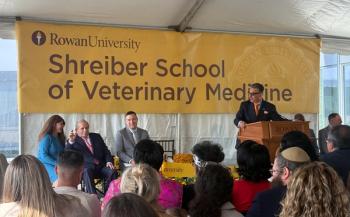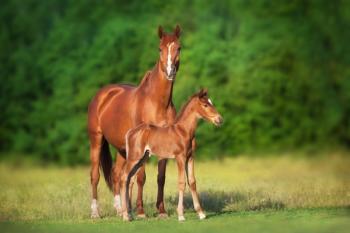
Let the laminitis data gathering begin!
U.S. and Canadian equine practitioners are asked to submit data for AAEP laminitis study.
The American Association of Equine Practitioners (AAEP) Foundation needs equine practitioners in the United States and Canada to help gather data for its first study as part of the Laminitis Research Project.
According to the AAEP, "The Laminitis Research Project is designed to unite veterinarians and horse owners in a collaborative effort to uncover new information about the causes, prevention and treatment of laminitis."
Alberto BN Junior /Getty Images
The intent of the project, supported by both the AAEP Foundation and Boehringer Ingelheim Vetmedica, Inc., is to collect data in a case-control study from first-time cases of pasture- or endocrinopathy-associated laminitis (PEAL) from equine practitioners throughout the U.S. and Canada. The study coordinator Michelle Coleman, DVM, of Texas A&M University's College of Veterinary Medicine says, "Our goal is to identify risk factors associated with the development of this form of the disease and to help identify strategies for future research."
Noah Cohen, VMD, MPH, PhD, Dipl. ACVIM, the principal investigator of the study, says, "It is our belief and hope that our study of naturally occurring cases of PEAL will identify factors that can be further investigated as means for preventing or controlling this form of laminitis. We are reliant on the goodwill and commitment of AAEP members in the United States and Canada to help us obtain the necessary information and samples from affected horses and unaffected horses that will serve as controls."
History of the Laminitis Research Project
Likely one of the most frustrating diseases equine practitioners face, laminitis damages the critical laminae structures of a horse's foot (Photo 1), often resulting in severe lameness and, in many cases, the need for humane euthanasia.
Photo 1: A radiograph of a horseâs foot with laminitis and resulting rotation of the distal phalanx (coffin bone). (Photo courtesy of Dr. Nathaniel White.)
Laminitis has been identified consistently as the highest priority for research investigation and funding by AAEP members. In fact, in two surveys in 2003 and 2009 conducted by the AAEP Foundation, AAEP members placed laminitis at the top of the list for additional research. This project is a result of that request to focus on laminitis research.
The need to focus on epidemiological studies was first initiated by participants in the AAEP Foundation's Second Annual Laminitis Workshop, held in November 2009. The AAEP Foundation then formed the Laminitis Working Group. This group initially met in October 2010 and set the direction to proceed with The Laminitis Research Project and the development of the first of many epidemiological studies.
"This project is in response to AAEP members prioritizing laminitis as the most important disease requiring research," said AAEP Foundation Chairman Wayne McIlwraith, BVSc, PhD, FRCVS, DSc, Dipl. ACVS. "We are fortunate and very grateful our long-time industry partner Boehringer Ingelheim Vetmedica, Inc., and their new exciting product Prascend is willing to support research to help us help horses with this devastating disease.
The Laminitis Research Project Advisory Board
"At one time, the foundation funded smaller research projects, but we thought it was time, based on our member surveys, that the foundation supported complete, focused research projects, and the first topic is laminitis," continues McIlwraith. "We decided that a lot of the work on laminitis has been experimental, but to prevent it, we need to know specific risk factors."
Susan Eades, DVM, PhD, Dipl. ACVIM, a member of the Laminitis Research Project Advisory Board, says, "From previous conferences, laminitis researchers identified the most important things that we need to know in order to proceed toward work on a preventative or a cure for laminitis. This research included discussions from basic science to clinical cases, but the most glaring thing is that we don't have enough information about the day-to-day cases of laminitis, as it relates to endocrine and metabolic disease."
In 2010, the AAEP Foundation gathered a group of experts for two workshops. Long-time Foundation Advisory Committee member Rustin Moore, DVM, PhD, Dipl. ACVS, was the facilitator for both workshops. Former Foundation Advisory Committee Chair and 2010 AAEP President Nathaniel White II, DVM, MS, Dipl. ACVS, represented the AAEP as an officer, as did McIlwraith.
"We planned this research to focus on the pasture-metabolic laminitis problem, which we hope will show us some of the factors involved with this type of laminitis, to lead us to ideas on how to prevent it," says McIlwraith.
Discussion then progressed into using an epidemiologic approach to investigate risk factors for the disease. The advisory group consisted of a variety of individuals in different research fields, including internists, surgeons and other interested practitioners. Because of his expertise in epidemiology, Cohen agreed to be the principal investigator of the study.
"At that time in 2010, the goal and the plan were discussed," says Coleman. "From there, I was hired to coordinate the project, to take over and sort through several of the details. This initial study will help us prioritize future laminitis research. The plan is to collect data for approximately one year, through the end of 2012."
A look toward future research
"Laminitis is a very interesting, complicated disease, particular to horses, and it's going to take a lot of money and effort to get everything done to solve it," White says. "Though we've had various models—the carbohydrate-overload model, the black-walnut model—we hope that by examining the epidemiology of the disease, we might discover some of the causes."
"The success of this project is largely based on veterinarian participation," says Coleman. "Our current goal is to maintain enthusiasm about the study and to continue to collect data from equine practitioners. We will keep AAEP members informed of our progress."
The Laminitis Research Project Advisory Board planned to meet again in March to look at a second project on weightbearing, support-limb (contralateral limb) laminitis (as occurred in Barbaro). This is a major problem for injured horses in equine hospitals and care facilities.
"We anticipate the weightbearing study will again need the collaboration of hundreds of AAEP members, clinics, equine hospitals and referral facilities to help us collect data," says McIlwraith. "However, details for this study are still being developed and will be defined at our next meeting."
That project will run concurrently with the current one and continue for the next couple of years. More funding is needed to start the support limb laminitis study. The AAEP Foundation has set out to raise a total of $1 million to support these planned projects and future research.
Data submission process and outreach
To contribute to the study, equine veterinarians will need to submit data from their first-time cases of PEAL. The data to gather includes the signalment, diet, housing and health management, morphometric measurements and blood samples from not only the affected horse but also two control horses.
"The case definition for laminitis for this study is for horses to have at least Obel grade 2 lameness," says Eades.
To sign up, practitioners are invited to visit the study website at
Upon registration, participating veterinarians will be sent all necessary study materials, including access to the study survey, instructions on performing morphometric measurements and blood collection and shipping supplies.
Coleman says they've already received some data from practitioners. "Initially, we sent a mailing and an email to AAEP members in late January 2012," says Coleman. "We will continue with updates in the AAEP 'Spur of the Moment' biweekly emails and continue to encourage veterinarian participation as needed. We have had a very good response from our first requests, but time will tell how much data we will collect."
Eades says, "We are asking a lot from veterinarians, perhaps. But we feel this has also been asked for by the AAEP membership, and we feel they will be willing to go the extra mile.
"We are tracking the data input by state. I've sent out emails to my friends around the state of Louisiana to get cases in, as Texas is beating us at the moment," Eades says tongue-in-cheek.
Ed Kane, PhD, is a researcher and consultant in animal nutrition. He is an author and editor on nutrition, physiology and veterinary medicine with a background in horses, pets and livestock. Kane is based in Seattle.
Newsletter
From exam room tips to practice management insights, get trusted veterinary news delivered straight to your inbox—subscribe to dvm360.






